#come learn about a truly wild piece of manga history
Note
I’d love to know about Yulma and how important it is to representation in shounen manga
This has been sitting in my askbox for a couple months (because I am incapable of punctuality), but anon sent this to me back when I was talking about Yulma over on my vnc blog. For those unaware, Yulma refers to Yu Kanda and Alma Karma from the manga D.Gray-man.
So the thing is, to be honest, I don't know if you can say Yulma is/was important for representation. They don't tend to get brought up as an example of representation (except by diehard d.gray-man fans like me, lol) in shonen, and their whole thing is complicated enough that I feel like the queerness of it all flies over a lot of people's heads.
However! They're very important to me personally, and I do think it's kind of remarkable their story came out in like 2010. Because even though their queerness gets overlooked a lot, it's like. really there no matter how you interpret it.
The short version of their very complicated story is that Kanda and Alma are a couple who were resurrected into new bodies. Alma was a woman when they were originally together in their past lives, but is physically male in the present. Kanda is still very much in love with them by the end of their story, which, depending on the reading, makes Kanda very bi and/or Alma very trans.
This sound like something you want details on? If so, let's talk about how D.Gray-man's fan favorite edgy badass toughguy character briefly became the star of his very own heart-wrenching tragic queer romance.
Here's a brief crash course in Yu Kanda and Dgm for the uninitiated:
D.Gray-man is a manga about a group of exorcists (in the loosest and most anime sense of the term) in the 1890s fighting a holy war against mechanical demons powered by the souls of the dead. There are two things you need to understand about this plot for me to explain Yulma:
The Black Order, the secret branch of the church that exorcists work for, has a long history of committing horrific human experiments to further the war effort.
Due to complications of world building, only a tiny number of people can become exorcists, and tracking down new ones is extremely difficult.
Yu Kanda is one of the exorcists, and though not the actual main character (that's the lad in my icon), he's a very important secondary character. Arguably he's the most important secobdary character, since he's the main guy's biggest foil and the first character to play deuteragonist in a major story arc. He's also a huge fan favorite. The character popularity polls that Jump used to do always had him and the mc going back and forth over who won #1 most popular.
Kanda was also a classic edgy toughguy character. His first two scenes are him almost murdering the main guy because he thinks he's an intruder, then complaining about people grieving for their friend too loudly. He never smiles. He argues with the righteous mc about wasting time/energy protecting civilians. He threatens (and delivers) violence on anyone that annoys him. He looks like this:
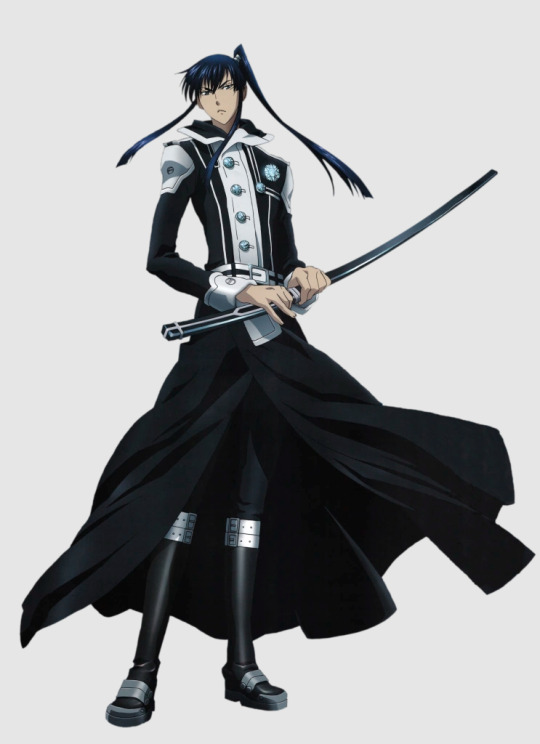
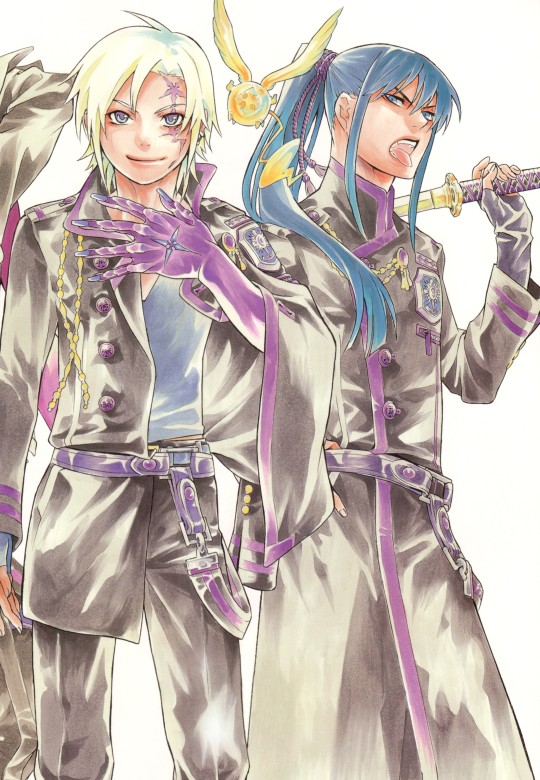
TLDR; Kanda was an adored-by-fans mean badass archetype in a 2000s shonen manga. Not generally the guy you peg for starring in a piece of queer romantic storytelling.
And for the entirety of the original anime adaptation's 103 episode run, for the first 188ish chapters of the manga, you do not learn a single thing about his early life. You learn he joined the Black Order very young, and you meet the mentor that took him in at that point, but although there are little hints, a couple cryptic mentions of him searching for a certain person, his early origins remain a complete black box.
Then came the Alma Karma arc.
This is the point where I start getting into spoilers.
To make a very long story short, the Alma Karma arc reveals that Kanda is one of the Black Order's human experiments. The Order ran a secret project 9ish years before the start of the series in which they essentially tried to re-use dying exorcists (since finding new ones is so hard). They took the bodies of dying or recently deceased exorcists and harvested their brains, implanting those brains into new magically grown child bodies.
Key to this project—the second exorcist project—is that these newly grown second exorcists were not supposed to remember anything from their previous lives. Kanda, however, recovered a few hazy memories from his past self. Most importantly, he can recall an unclear image of the woman that his past self was in love with. This memory gradually becomes Kanda's reason to live. He wants desperately to find and meet that person.
Now, aside from Kanda, there was one other successfully revived second exorcist. This was a boy named Alma Karma.
Over the course of their brief shared childhood, Kanda and Alma become extremely close. However, due to a series of horrible events that I'll spare you the details of, Alma is eventually driven to murder-suicide. He wants himself and Kanda to die together to spite the Order, and Kanda almost lets him do it.
The one thing that keeps Kanda from letting Alma kill him, the thing that drives him instead to kill Alma, his most beloved and only friend, is that he can't bear to die without finding that woman again.
Have you figured out the twist yet?
9 years later, in the present, Kanda discovers that he didn't actually quite kill Alma. The Order kept Alma secretly half-alive in order to do more dubious experiments. And, more importantly, when they meet again, Kanda discovers the truth. The woman that he's been searching for his whole life, the woman he's in love with, the woman he tried to kill Alma in order to find, was also killed and made into a second exorcist. And her brain was placed into the body of Alma Karma.
After quite a lot more violence and tragedy, Kanda and Alma end their story arc by running away together on their deathbeds. Alma dies, for real this time, in Kanda's arms, and his last words are to tell Kanda he loves him. These words are presented as something Kanda hears from both the boy and woman versions of Alma's soul.
So! At the end of a very long and complicated story, one thing holds true: Kanda and Alma are in love. As passed down from their past selves, they are specifically in romantic love. They were a couple. And to speak as a fan, the sheer absolute devotion to how Kanda's love for Alma is presented is seriously intense and moving.
Now, given the absolute hell that is Alma's life, gender identity is frankly the last thing they have time to worry about, so it's hard to say how the whole "literally a woman's brain in a male body" thing might have settled for them if given time to think about it. But that is inherently a pretty trans narrative. And given the whole Alma gender situation, there's simply no reading of their whole situation where neither of them is queer.
If you take present day Alma as a guy, which is more or less how he's presented in canon (though again, who knows how he would've felt about that male body in different circumstances), then congratulations! You've got mlm in your shonen manga. They were straight in a different life, but now one of them's a dude, and they are still deeply in love with each other. They've even got not one but two "let's forget it all and run away together" scenes, just as every mlm couple seems to have.
On the other hand, if you go with the angle that Alma's still a woman based on her mind/soul, even in her new body, then Kanda may not be canonically queer, but Alma is inarguably trans. Again, literally a woman's brain in a male body. It may not be how most people end up trans, but that doesn't change the facts of her situation.
You see what I mean about how they're undeniably queer, but also kind of easy to miss? There's so much other insane shit going on in their story that Alma's whole gender situation can get passed over. Plus, you can look online to this day and find people arguing that Kanda's not "technically" explicitly in love with the present day male version of Alma, since he doesn't 100% unambiguously say as much. I love reading comprehension.
Also! As a possible extra reason for why people don't talk about them much, the official English translation of the manga translated Alma's final "I love you" very differently. There's always a lot of nuance and argument when it comes to translating "大好き" into English, but given the full context of their relationship and the scene it's in, Viz's handling really sets off the censorship bells in my head.
Here's the different versions (Japanese then fan then official), if you want to compare:
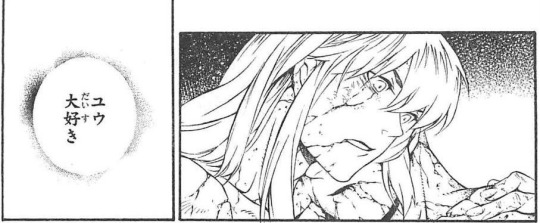
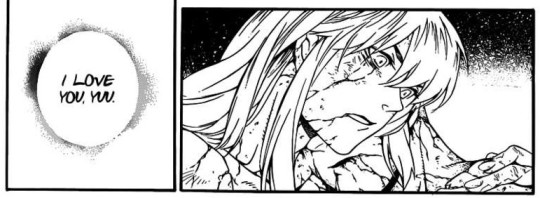

Nothing more classically queer than censorship by way of questionable translation 🙃.
At the end of the day, Kanda and Alma are in kind of a strange middle ground. They're each in love with the other one, but the whole second exorcist brain transfer situation makes it complicated enough that people argue their feelings aren't explicitly romantic (and thus not gay) in the present. Alma is literally a woman's brain implanted in a male body, but we don't have time to dwell on the gender complications of all that because of the hell that is the rest of their life. They're canon but not canon—queer people whose stories don't have space for them to be queer.
However, given that all this messy, tragic ambiguity was published in a fairly popular shonen manga back in 2010, it still feels kind of remarkable to me. Alma is somewhat an antagonist (it's complicated), and he dies at the end of his arc, but once again, Kanda was/is the fan favorite! And when he re-enters the main story after Alma's death, he's more important than he's ever been, and his history with Alma continues to be a huge part of his character.
Katsura Hoshino took the much-beloved edgy toughguy character from her long-running shonen series and, after keeping his origins secret for such a long time, confirmed that his whole life has revolved around love this entire time. Almost every facet of his character can be traced back to his love for his lost best friend or his yearning for his past life's missing partner. And then she reveals that the best friend and the partner are one and the same.
You can go back and forth about the degree to which they work as representation, but in any case, I think their story is something people ought to know about. It's romantic and it's heart-wrenching and it's fucking wild, especially given the context in which it was published (a Shonen Jump spinoff in 2010). I never see anyone besides the few remaining hardcore dgm fans talk about them, and I think that's a shame.
So anyway, that's tale of one of the most insanity-inducing romances I've ever seen put to paper. I love queer people.
Here's some choice pages if you want to cry with me (the last two are a sequence):
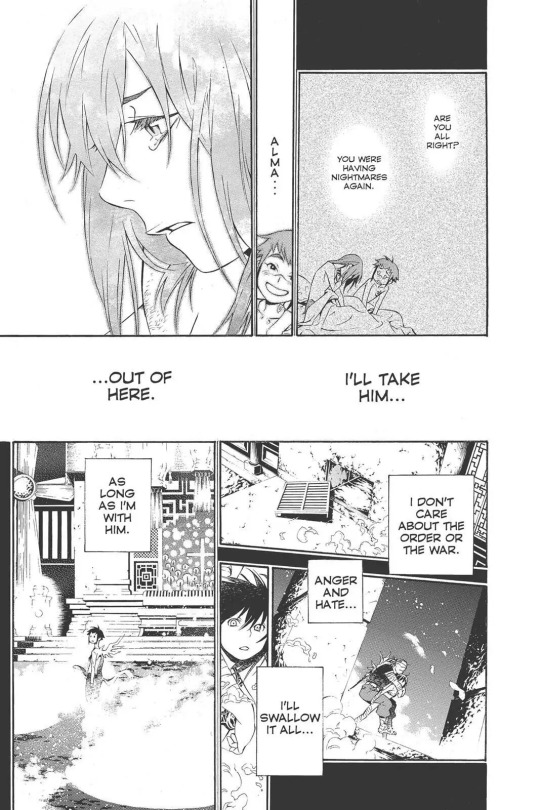
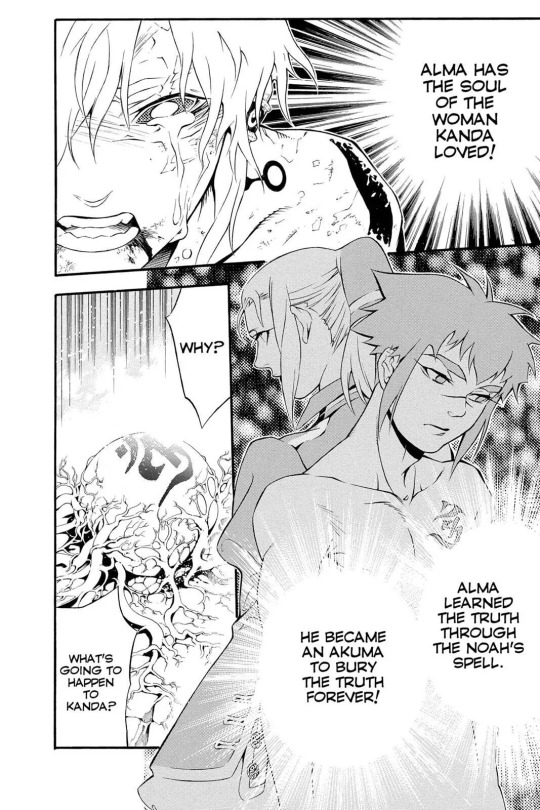
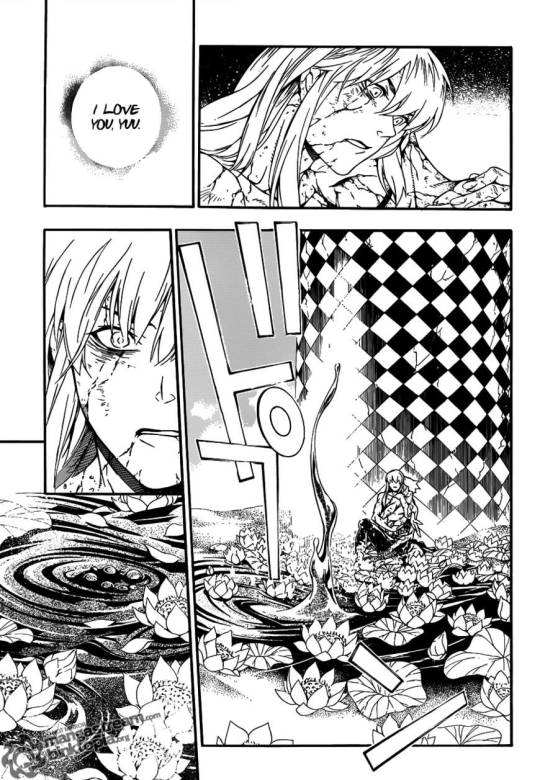
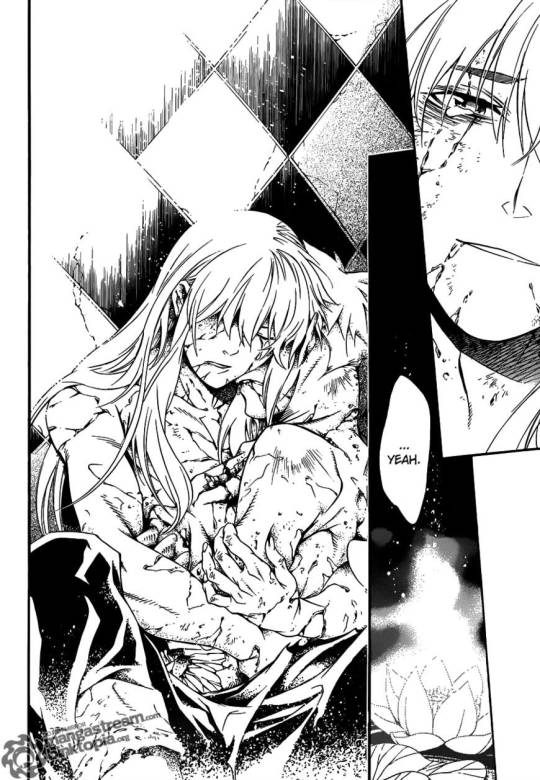
#followers!! I know my demographic#I know that most of y'all are Tragic Queer Romance Enjoyers#and if that describes you. you should read this post#come learn about a truly wild piece of manga history#I bring you the gift of discovering Yulma without having to read almost 200 chapters of shonen manga for context#don't pass this up <3#dgm#d.gray-man#yu kanda#yulma#alma karma#invasion of the frogs#also I really hope that at least one of the besties reads this and has a Realization about who/what my queue tag is a reference to#maybe I flatter myself to think that anyone remembers what my queue tag is. but I just think it would be funny <3#also also. I really did not intend for this post to turn into an entire essay when I started writing it#so uh. whoops#ID in alt text#anon#ask
176 notes
·
View notes
Text
April 19, 2022
Today, while I was waiting on my dorm-mates to head off to school, I experienced a level 2 earthquake! I was standing still, reading my kindle, when I felt it and heard some windows rattle. The dorm-mates who came down just minutes later hadn’t noticed it because they were moving around getting ready when it happened. A true level 2. I’m kinda curious what the higher level ones are like, but I also kinda don’t want to know (I think I’ve already said this, but I’m gonna repeat myself anyway).
Today, class started with a grammar test. The grammar itself I was good on, but I forgot a couple key vocab words so I probably got a few wrong. There’s only a couple people in my class who are still online at this point. It’ll be nice when we’re all in person. I had to practice conversation with one of the online people today and the audio kept cutting in and out, so I mostly kept repeating 「すみません、聞こえません。」 (excuse me, I can’t hear) and it was painfully awkward because I think the guy thought I was just being stupid.
After class, we had yet another orientation (at this point, I honestly don’t know how many different orientations this school has put me though). This one was for the culture class. Since I’m not taking these classes for college credit, the culture class stuff was entirely optional for me. However, I opted in for all the lectures and excursions. Like, this is part of what I’m paying for, so I’m going to do it. Plus a lot of it sounds really interesting to me (though it may not have sounded interesting to me years ago had I come at a different age). One of the days is split between learning about the history of Japanese fire extinguishing and visiting a place that teaches about natural disaster preparedness. I’m intrigued. Plus there’s a whole day trip where they’ll take us out to Kamakura to see the 大仏 (great Buddha statue). I’m stoked.
First culture class will be this Saturday. We’ll be learning about Japanese traditional art then touring around the Diet building, Imperial Palace, and Asakusa. It’ll truly be like being a tourist. I can’t wait.
After I got back to the dorm, I went out to check out the BOOKOFF Plus nearby. I loved used bookstores. I’m going to have to keep myself in check with this place otherwise I’ll be paying extra baggage fees when it’s time to go home. Today, I managed to limit myself to two manga volumes from some of my favorite mangas. Both were only 110円, which is part of why this will be so easy to over-do. Right now, that’s less than a dollar a piece.

Yes, both are romance mangas. No, I am not ashamed of that. I’ve learned to fully embrace that I enjoy reading in the romance genre. And I’ll fight anyone who tries to say anything about that.
Anyway, as I was preparing for dinner, I realized that I was having the same thing for both lunch and dinner, but at wildly different qualities. For lunch, I had kitsune udon from a restaurant near my school (it was a restaurant that uses the meal ticket machine! exciting!), and for dinner, I had instant kitsune udon from the 7/11. Honestly, the slab of tofu was my favorite part of both. The broths were lackluster and the noodles didn’t particularly stand out. The pink things are slices of fish roll or something, I think, and those didn’t particularly interest me, either.
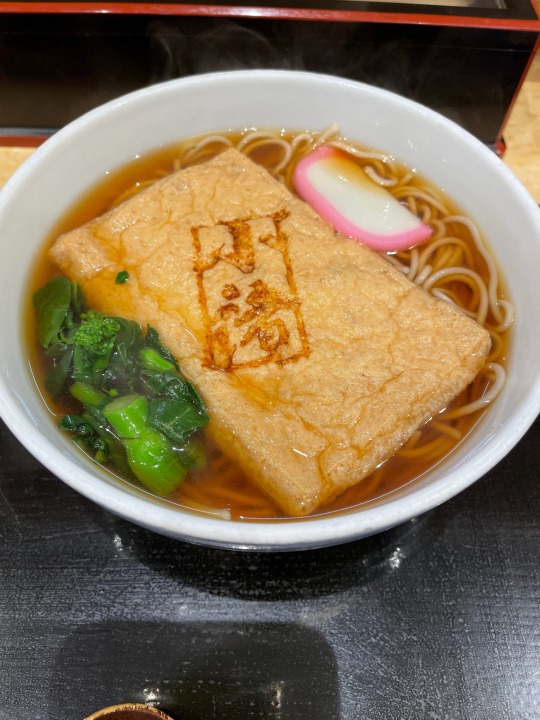

Honestly, my favorite foods here so far have been curry rice, katsu curry rice, yaki-onigiri, and inari-zushi. Very basic foods. But I’ll keep trying to branch out and try things. I just wish I was more of a fan of fish, so I could truly enjoy what Japan has to offer.
It’s wild to realize I’ve already been here for two weeks. It doesn’t feel like it could have possibly been that long, but it also feels like I’ve been here forever. My six months here are going to fly by. I need to make sure I stay aware of how much time I have left in Japan so I can make the most of it!
0 notes
Text
OPINION: What Can We Expect From The Upcoming ONE PIECE FILM RED?

Hello everyone, and welcome to Why It Works. Having spent the last year consuming the entirety of the One Piece anime, the Straw Hats have established a permanent bulkhead in my brain. When I’m not actively reading or watching One Piece, I often content myself by speculating about future One Piece, which is almost as good as One Piece that already exists. At the moment, we have a prime target for pirating speculation: the upcoming ONE PIECE FILM RED, which promises to feature One Piece’s most important yet under-explored character. We can’t entirely plot out FILM RED from what we already know, but between the film’s few released details and our general understanding of One Piece films, I can still make a pretty informed stab at what I expect and hope for from the production. Let’s see what we can divine from the tea leaves of data and experience!
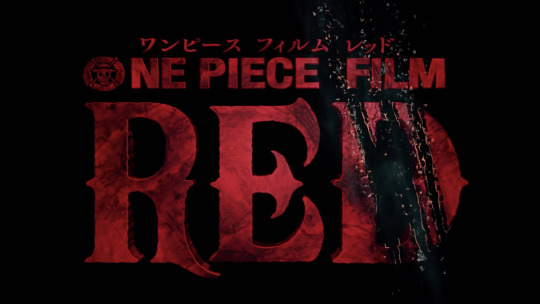
Starting off with the information we know, it’s been clear from even the title announcement that this film will focus heavily on Red-Haired Shanks, as his signature scars are built right into the logo. Shanks is without question the most important as-of-yet undeveloped character in One Piece mythology. His history with Roger and status as one of the four emperors make him a critically important figure in One Piece geopolitics, while his unique bond with Luffy makes him even more important in terms of the manga’s emotional journey. He’s literally the man who gave Luffy his signature hat and who “bet” on Luffy’s future at the cost of his own arm. It would appear Shanks’ full story is being saved for the final act, meaning FILM RED might well serve as a preamble to those reveals.
Along with focusing on Red-Haired Shanks, we’ve recently learned that the theme of the Straw Hats’ film outfits is “rock x pirates,” with the whole crew now featuring some spiked-up punk ornamentation. That character art was further conveyed in a very specific fashion: the video opens on a blank page of sheet music, which is then contorted into the Straw Hats’ forms. On top of all that, the accompanying poster features a woman we don’t know mid-song, along with the words “An almighty voice. With fiery red locks.”
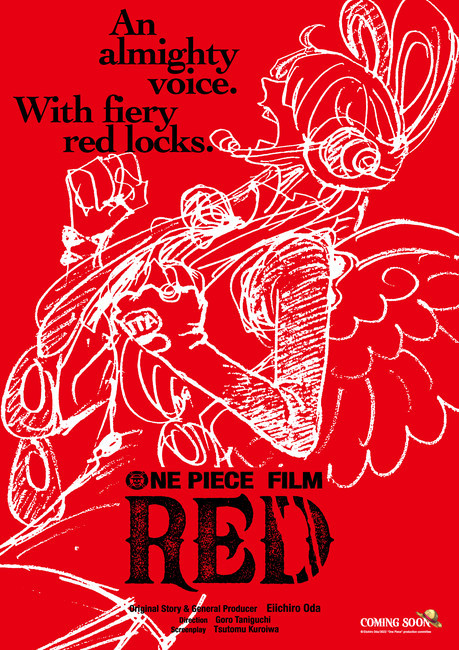
Image via Toei
All of this strongly implies that Red will most likely have a rock concert theme, following in the footsteps of predecessors like Gold’s casino theme. That sounds like a fantastic choice, and one in keeping with One Piece’s general structural advantages when it comes to tie-in films. Rather than having to awkwardly slot new adventures into a fully continuous narrative, One Piece films can take advantage of the natural “chapter breaks” provided by the manga’s island-based, quasi-episodic structure. As a result, any given film can focus on an island the crew could have visited, providing uniquely themed amusement parks for the crew to run wild through.
Our understanding of One Piece films can provide a lot more than the presumably uncontroversial “it will probably take place on a themed island.” The rules of tie-in films are admittedly a little loose; take the contrast of Stampede and Z, for example. Stampede literally couldn’t exist at any point in the One Piece timeline, as it featured a wide variety of characters who were otherwise occupied at the only points it could occur. On the other hand, the release of Z was directly seeded and alluded to by the TV production, presenting far more ambiguity as to its canonicity or ongoing significance.

The overarching philosophy seems to imply that, while Oda-produced films are closer to show-canonical, nothing that happens in any One Piece film can be truly essential to the series’ story. No reveals that impact the core narrative, no characters that come up except in isolated or film-specific contexts. Ultimately, any One Piece film must be excisable without losing any meaningful context for the ongoing One Piece story.
As a result, I am sad to say it’s unlikely FILM RED will reveal any of the secrets we’re clamoring for regarding Red-Haired Shanks. Shanks is simply too important of a figure for his backstory to be relegated to a supplemental film. It's almost without question that the answers he’ll provide will tie in directly with the grand question of the One Piece itself, along with the significance of the straw hat. Red-Haired Shanks has made his entire personality a load-bearing column of mysteries, and the resolution of those mysteries will signal the approaching end of One Piece itself.
So what does that leave us with? Personally, I’d put money down that FILM RED will be focused on a character who was also inspired by Shanks, and rather than following that inspiration into piracy, they express their passion through music. While they could be related to Shanks, I’m more expecting their common red hair to be exploited as a setup: Luffy will mistake gossip about some red-haired celebrity for news of Shanks, only to discover this musician instead. We’ll get fond memories of how Shanks touched their life, Luffy will bond with them about the feelings they share, and it will all culminate in some spectacular battle-concert, with the Straw Hats defending their new companions as guitars roar in the background.
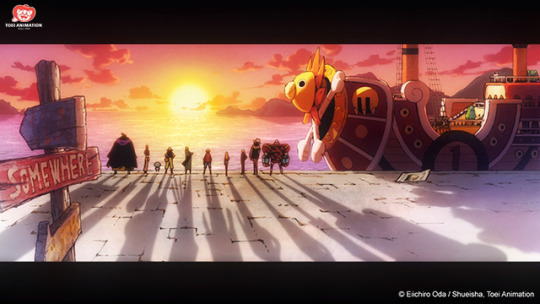
FILM RED may not provide the answers fans are waiting for, but I’m certain it will still be an absolutely staggering spectacle. In this era of Wano’s continuing magnificence, the idea of a film actually going above and beyond what the TV anime is achieving seems almost unimaginable. And a rock concert-themed One Piece movie? How cool is that!? Whatever answers it may or may not hold, I’m beyond hyped for FILM RED and can’t wait to see the Straw Hats on the big screen.

Nick Creamer has been writing about cartoons for too many years now and is always ready to cry about Madoka. You can find more of his work at his blog Wrong Every Time, or follow him on Twitter.
By: Nick Creamer
0 notes
Text
Anime News Network - Inside The Manga Industry with Felipe Smith, American Mangaka (Part II)
In the second part of our interview (find part one here), Smith explains how manga distorted his expectations of life in Tokyo a bit, how working with Kodansha got him to look harder at genres and audiences, and what four crucial tips must be followed by any American otaku hoping to work in Japan, too.

Did working through Kodansha's demands for PEEPO CHOO develop any skills you've found useful on subsequent projects?
The quick and simple answer is a huge, resounding... yes! The rigorous schedule and incessant deadlines I kept while creating manga in the Japanese market actually prepared me to work full-time simultaneously in two industries back in the US! Upon my return in 2012, I was hired by Nickelodeon as a storyboard artist – and later character designer – for the Ninja Turtles animated TV show.
During that time, I was approached by Marvel to revamp the Ghost Rider franchise. I created Robbie Reyes, wrote 21 issues of his monthly comic, drew two of them and illustrated covers for ten of them.
So, from 2013 to 2017, I worked in both animation and comics full-time, at the same time. It was a bit nightmarish, but definitely worth the effort. And it was a possibility, in part, thanks to my Japanese publishing boot camp experience.
With that “double-duty” wrapped this year, you've turned to a new project Death Metal Zombie Cop, which was funded through Kickstarter. How does it differ from your recent output?
[It's] my return to creator-owned comics and I'm very excited about it. I've been developing it since the end of PEEPO CHOO back in 2011. In creating it, I'm applying everything I've learned from the Japanese and American comic markets and I can't wait to release it!
You've said you got the idea while wrapping up PEEPO CHOO. What was the inspiration?
...A combination of factors. The most important of which is the need to tap into an identifiable genre with an established audience. Neither of my previous graphic novel series, MBQ or PEEPO CHOO, fit neatly into any genre. I could say, with no real risk of sounding bumptious, that both titles are pretty singular in their approach and subject matter – something I've always strived for. But, by the same token, though well-received, they did not reach a tremendously expansive audience, either.

Did your run on Ghost Rider shape the idea, too?
In contrast, [it's] probably my most-read comic book series to date. It's very true that because it is a Marvel book – and an expansion on a well-known franchise – it already had significant interest and an expectant fan base before its release. But I believe that genre specificity had a great deal to do with its greater success, as well. All-New Ghost Rider is an anti-hero “action” comic with elements of horror. Those are two tried-and-true genres with an important audience, and well-established tropes upon which to expand.
Sounds like these projects got you to consider potential audiences in different ways?
A fanbase is the life of a creator, and is essential to his or her existence and prosperity. A good creator will foster and grow a fanbase independently. But fitting neatly into genres – as was [explained to me] in Japan – can help a creator unite his fanbase with greater speed and efficacy. Thus, upon finishing PEEPO CHOO – and after four original series pitch rejections – I decided to try my best to find a story I could be invested in and tell effectively that would also fit in a designated, easy-to-identify genre… for once! [Laughs]
So, I picked horror and action – genres I've always liked – and then added “cops and crooks,” which is also a personal favorite of mine. What's funny is that the “zombie” genre element didn't really come into play until later in the development of the pitch, but once I found that piece of the puzzle, my mind was blown. I had never created a story with any supernatural elements, because I'd always strayed away from superheroes. But now, I found myself with a whole new set of storytelling possibilities and I got really excited.
So, your horizons were expanded, both literally and figuratively, after having to see the notion of genre from a different angle over in Japan?
As I mentioned earlier, the one series that caught the interest of my Japanese editor was also the one I eventually decided would most likely find a better place with a Western audience, and it was Death Metal Zombie Cop. As I also mentioned, upon my return to the US, Nickelodeon hired me on TMNT, and then I got a call from Marvel. And when the editor mentioned that he'd like me to pitch him an idea for a Ghost Rider in a car [as opposed to on his traditional motorcycle], and that I was pretty much free to create everything from the ground up… I had a few things I was dying to test out on the American direct market audience.
Now that I'm finally putting together Death Metal Zombie Cop, I can't say I'm really approaching it very differently than my previous creator-owned work. The major difference is that this series will be in full-color and I plan to release 24-page monthly issues, like an American comic series.

PEEPO CHOO explored the misconceptions American otaku have about Japan. How might manga give US readers – and aspiring creators – a skewed view of life across the Pacific?
That's a good question. Although I've found that the largest portion of Japanese manga stories take place somewhere in real-life Japan, near real-life Japanese landmarks and during some time in real Japanese history – whether it be past or present – in my experience, a great number of the “Japanese” characters portrayed in these manga do not truly reflect the character and behavior I've observed in the Japanese people.
What shaped your expectations before moving there, then?
...My only real perspective on Japanese culture, like that of many Westerners, was derived from what I saw on their TV shows, live-action or animated, read in manga or magazines, or from any Japanese person I happened to meet. Obviously, first-hand conversation and discussion with people is your best bet, when it comes to trying to understand or familiarize yourself with their culture.
Having lived and worked with Japanese people in LA, I was lucky to learn their culture in action, first-hand. The more I learned, the more I realized that the fictional manga characters I presumed to be realistic because of their true-to-life surrounding locations and attire were anything but.
What specific details might ring more realistic?
[If you are] the least bit observant, you'll see that people do not hug very often, nor high-five each other. “High-touch” is how it's referred to in Japan. And, in my experience, unless there's celebration or alcohol involved, they're rarely prone to any kind of loud outbursts of emotion, wild arm or body gesticulation, or very expressive facial communication. It only takes watching a bit of Japanese TV carefully to discern who is being a TV character and who is just a person [that] happened to be filmed by the camera.
In contrast, a huge number of characters in all media [all over the world] behave astoundingly differently from the norm. Imagine if every person you saw on TV behaved and talked like Ace Ventura, Pet Detective. You'd find that pretty strange. This is a topic I brought up to my editors on more than one occasion...
Were you trying to strike the right balance of realism and surrealism?
The concept of “reality” is something that I believed was essential to establishing a believable story scenario. The way characters behave and react to situations is a reflection of that reality. So, if I ever wrote a scene about a person riding a public bus, I would want all the details to be right and make sense…
“Does this person pay with coins or with a card?”
“If they're approached by an inebriated or deranged homeless person, what would they most likely say?”
“If they witnessed someone stealing from or hurting another, what would they do?”
If the character reacts to any of these situations in a plausible manner, then it's realistic, and therefore based on reality. Unless it's a comedy. In [that] case, we are now playing with the conventions of what would normally occur and turning them on their side.
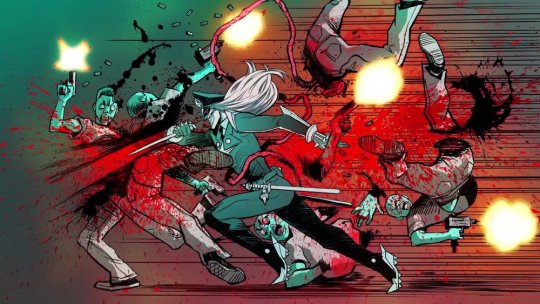
Did this anthropology study reveal even more about the manga business, in turn?
...Partly because I'm a foreigner, I found myself noticing more and more that these characters on TV, in movies and in manga… in many cases [they] displayed very uncharacteristic behaviors that did not match what I saw on the streets in real life. This truly confounded me, because I realized that my telling of reality in a story seemed to actually be of little importance in the overall scheme of manga storytelling! [Laughs]
I remember telling my editor, “Where's the reality in these stories? People don't own guns in Tokyo. People aren't this outspoken. People don't behave like this here. This isn't real. What's this based on? It's not reality!”
My editor simply answered, “Who cares about reality? As long as it's interesting [and entertaining], it's good.”
Sounds like you went through a process of enlightenment, much like the characters in PEEPO CHOO?
Unlike Milton [the manga's otaku protagonist from Southside Chicago], it was obvious to me that one cannot equate a country's cultural reality to its popular entertainment. [Still], I had no idea how oddly removed from reality I'd find certain aspects of everyday Japanese storytelling – be it in manga or just regular TV. I guess I learned that when it comes to Japanese entertainment, we should seek [it expressly as entertainment], rather than [as] “reality” or “truth”. [Laughs].
How was the series received by Japanese readers? Any surprises?
PEEPO CHOO was positively received by reviewers as a series worthy of merit for being the first of its kind. It also confused some readers, who took to the 2chan internet forums to discuss it and me as a creator. Some speculated that I was just a Japanese mangaka who wrote under a gaijin-poi “foreigner-like” pen-name to try to get attention. Others did a little internet research, found my earlier work – photos of me – and commented on how “he looks more like a soccer player than a mangaka!” [Laughs]
I remember my editor mentioning that some readers wrote in to the magazine commenting on my art – which they liked – and on how they had a hard time understanding the motivations of some of my American characters.

Speaking its reception, if anybody types “Felipe Smith Japan” into YouTube's searchbar, they'll find some interesting videos, won't they?
PEEPO CHOO also received some TV coverage on a few shows, including NHK's documentary show Manga No Genba – “The Place of Comic Creation” – which filmed me working in my apartment and walking around Tokyo running daily errands. [I was also on the] comedic duo Oriraji's show Manga No Hi – “Comics Day” – in which I had five minutes to pitch my series' premise to a panel of judges live, in Japanese.
Did you encounter any misconceptions about America throughout this?
...Upon meeting me for the first time, my editor assumed I owned firearms in the US – which I don't – and a few more silly things that escape me at the moment. [Laughs] But, encountering strange misconceptions and being asked outlandish questions by locals is pretty common when you're a Westerner living in Japan. It's something you just kinda grow used to.
What advice do you have for any American cartoonists who'd like to follow in your footsteps?
“Eat your veggies, get your sleep, learn Japanese and get to work!”
Creating manga professionally for a major publisher has a quantifiable effect on you mentally and physically due to its rigorous schedule, so it's important for you to eat healthy and get proper rest as much as possible. Sitting in a seat for 12 to 18 hours a day can have a lasting negative effect on you if you let it, so stay active and pay attention to your health.
Do they need to go to the lengths you went to, though – flying over and taking residency in Tokyo?
I've said it before, and I'll say it again… you don't need to be in Japan to create manga. But, if for some reason you want to do it in Japan, you need to speak the language in order to articulate your ideas to an editor. If that's taken care of, and your series concept is accepted, get ready to write and draw non-stop for very long periods of time – rain or shine, for as long as your series goes, regardless of whether you feel like it or not.
With no exaggeration or intent to dissuade, I can tell you from my own personal experience that a professional mangaka has little time for anything other than making manga. I can say, with honesty, that within the arts, it's a profession best suited for a very particular kind of artistic maniac.
#Felipe Smith#Peepo Choo#Japan#Manga#Kodansha#Felipe Smith Comics#Felipe Smith Art#フェリーペスミス#ピポチュー#漫画
134 notes
·
View notes
Text
Monthly Mangaka Spotlight 9: Takehiko Inoue
Hey gang, and welcome to the 9th installment of Monthly Mangaka Spotlight, featuring Takehiko Inoue!
I will be completely honest starting from here. At first I decided to take Takehiko Inoue for two reasons. Firstly, I really want an excuse to read all the Vagabond again, it's a statement I feel I do not need to justify. Second, he had three famous manga enough to read my book not starting with an animal hunt. Also, Nate has made me read the Slam Dunk for years now and I thought writing an article about it would eventually bring this to the rest.
When you are best known for almost single-handedly popularizing a sport in your country, you can rest assured you probably did something noteworthy. Takehiko Inoue’s Slam Dunk did just that, bringing basketball to national attention in Japan and winning awards from publishers, fans, and the Japanese Basketball Association along the way. A true fan of the sport, Inoue leveraged the popularity into the Slam Dunk Scholarship Program run by its publisher Shueisha. Not bad for only his third best manga.

Inoue spent just less than a year as an assistant, working with Hoko Tsukasa on City Hunter for 11 months. His first published work was Purple Maple in 1988, a simple short about Akagi, a high schooler, whose basketball team challenge his rivals in a regional tournament in a fight over a girl. Although his art was already exceptional, the simple plot was typical of a first work and showcased his obsession with basketball. Although Inoue himself has not confirmed it, many of Inoue’s fans consider Purple Maple the trial run for Slam Dunk.
Slam Dunk, a 31 volume series published between 1990 and 1996 Weekly Shonen Jump, is easily the series most synonymous with Inoue’s name and likely more than a little autobiographical in nature. Much like Inoue himself, the protagonist, Hanamichi Sakuragi, joins his school’s basketball team to impress a girl. Also like Inoue, Sakuragi is egotistical and fancies himself a prodigy at basketball before even playing his first game. Unlike Inoue--probably--he is extremely physically gifted, considered an unbeatable monster among the delinquents from his previous school.

The story of Slam Dunk is one of personal growth. Despite all his advantages, Sakuragi is forced to come to terms with the fact that personal strength will only get you so far and it takes dedicated work to become a great basketball player. Sakuragi learns humility and grows as a person all while the reader enjoys Shohoku’s triumphs, high school hijinks, and Inoue’s artwork during the period he really comes into his own as an artist. Although basketball is the vehicle upon which the story rides, what makes Slam Dunk so iconic is the strong characters and excellent pacing of the manga.
After Slam Dunk, Inoue began work on a manga i like to call “the Japanese Space Jam”. Buzzer Beater, a four volume series originally published in Monthly Shonen Jump, was Inoue’s third--and, in my opinion, last---series to focus on basketball. The manga had a much more flamboyant style and character design than Slam Dunk, taking place in a setting in which intergalactic alien teams dominate the sport of basketball. Hideyoshi Tanaka is an orphan living in New York who makes his living hustling people in street basketball who is drafted into the Earth’s team which may just have a chance at winning a championship.
During his work on Buzzer Beater, Inoue contemplated ending his career as a mangaka, feeling he had nothing else to contribute. One of his editors at Morning recommended he read the novel Miyamoto Musashi by Yoshikawa Eiji. While reading the book, Inoue felt the desire to draw the faces of the characters, which eventually resulted in his decision to write Vagabond. In retrospect, the shift from Slam Dunk to Vagabond seemed almost natural for Inoue. Sakuragi and Musashi are similar protagonists being young, egotistical prodigies, but Inoue’s Musashi is a force of nature.

An ongoing series first published in Weekly Morning in 1998, Vagabond chronicles the early life and development of the legendary Miyamoto Musashi from a wild boy to the greatest philosopher swordsman in the history of Japan. The series has the atmosphere of mythic quest, a series of individual, almost allegorical, lessons that Musashi must overcome to reach the next stage of his odyssey to become “invincible under the sun”. Inoue’s portrayal of Musashi is unique among both fictional and historical works. My personal theory is that Inoue is drawing upon the true archetypical force of Musashi, which must be enormously stressful for him. Inoue has put the series on hiatus a number of times due to health concerns without halting work on REAL.
REAL, an ongoing series published in Weekly Young Jump since 1999, is perhaps the most aptly named manga I have ever read, although Way Too Real may have been better. On the face of it, the manga seems to be about a number of characters related to the wheelchair basketball team named the Tigers, but basketball takes a back seat to the real theme of the series. Describing it as a more serious take on Slam Dunk is simply inaccurate. The closest comparisons I can conjure are to JUST Jude Law’s tumultuous character from the ‘90s science fiction film Gattaca or perhaps a perspective piece placing the reader in the shoes of Robin William’s character in Awakenings.
I don’t often like to discuss themes in manga because my experience studying authors has taught me that almost 100% of the time they are unintended if not entirely opposed to the author’s intentions. Even Inoue will admit that he never has a theme going into a particular work, but they tend to crystalize over the course of his writing and he is able to distinguish them in retrospect. With REAL, it's overcoming personal disaster, and the manga absolutely does not pull punches. In heartfelt series like One Piece, action and drama build to crescendos that crystalize into singular evocative moments, but REAL seems to touch upon that rarity in every chapter as it describes every small tragedy of the characters autonomy being taken away piece by piece and their fight, both with their personal hopelessness and with their new physical and social limitations, to take it back.
Inoue’s is a self-described egoist who endorses that personality type in his own works and therefore has paid close attention to his own development as a mangaka. Like many artists, he looks back at his earlier work with a feeling of embarrassment. He takes pride in his work, both in terms of quality and quantity, saying in one interview “One story is 150 frames. I've been known to make three in five hours”. He feels that in his early days as a mangaka, all he wanted to draw was “cool” things, but as he grew more mature he broadened the scope of his work, becoming drawn to illustrating ugly characters and portraying bad people.
Even early on it was plain to see that Inoue was going to become something special as an artist. The way he captured the movement of Shohoku’s players in action showed both his intrinsic understanding of the movement as a basketball player and a tremendous grasp of anatomy. Many of the most impactful panels in his works would not be possible without his mastery of portraying mood through shading and capturing emotion through expression. It is not an exaggeration to say that he is one of single most gifted artists in the industry. His illustration truly are art and are evocative in their own right, combined with his vivid characters, Inoue has produced some achingly beautiful moments. Inoue credits his use of a brush for the unique appearance of his art, stating that he began using one during Vagabond when he realized Musashi's rival, Kojiro Sasaki, could not be drawn with a pen.
To Inoue, story is second to characters. He has said that truly vivid characters will tell the story all by themselves. Each character requires that he draw something from himself and face the same challenges as them. Once he has a vivid character, he said, the story comes naturally as a result of their struggle. In that way, Inoue attempts to write each manga as if it were their documentary, with all the respect to the individual that entails. It’s easy to see how that may come naturally to him as so many of his characters likely face the same challenges as Inoue himself. Young and confident but uncertain about their futures, talented but forced to confront the fact that they will still have to work hard to succeed. To a one they realize they must overcome challenges to eventually meet the standards demanded by their high opinion of themselves.
With such a transcendent artistic talent, it is truly remarkable that Inoue’s writing could be considered equal to his illustrations. Although he humbly stated that he hadn’t thought himself good enough at art to become a fine artist, Inoue seems to have the opinion that creating manga is more difficult. Unlike artists, who must convey beauty on a canvas, with mangaka beauty is not enough, since they must create stories which must have meaning and entertain. In terms of raw work, only catching two hours of sleep a night when a deadline draws near, despite having a team of five assistants supporting you, Inoue certainly presents a strong argument. Much like his protagonists, Inoue’s ability is likely the result of tremendous talent honed to its absolute potential through an unbelievable amount of work. Only that could produce the works he has created.
Source: crunchyroll
1 note
·
View note